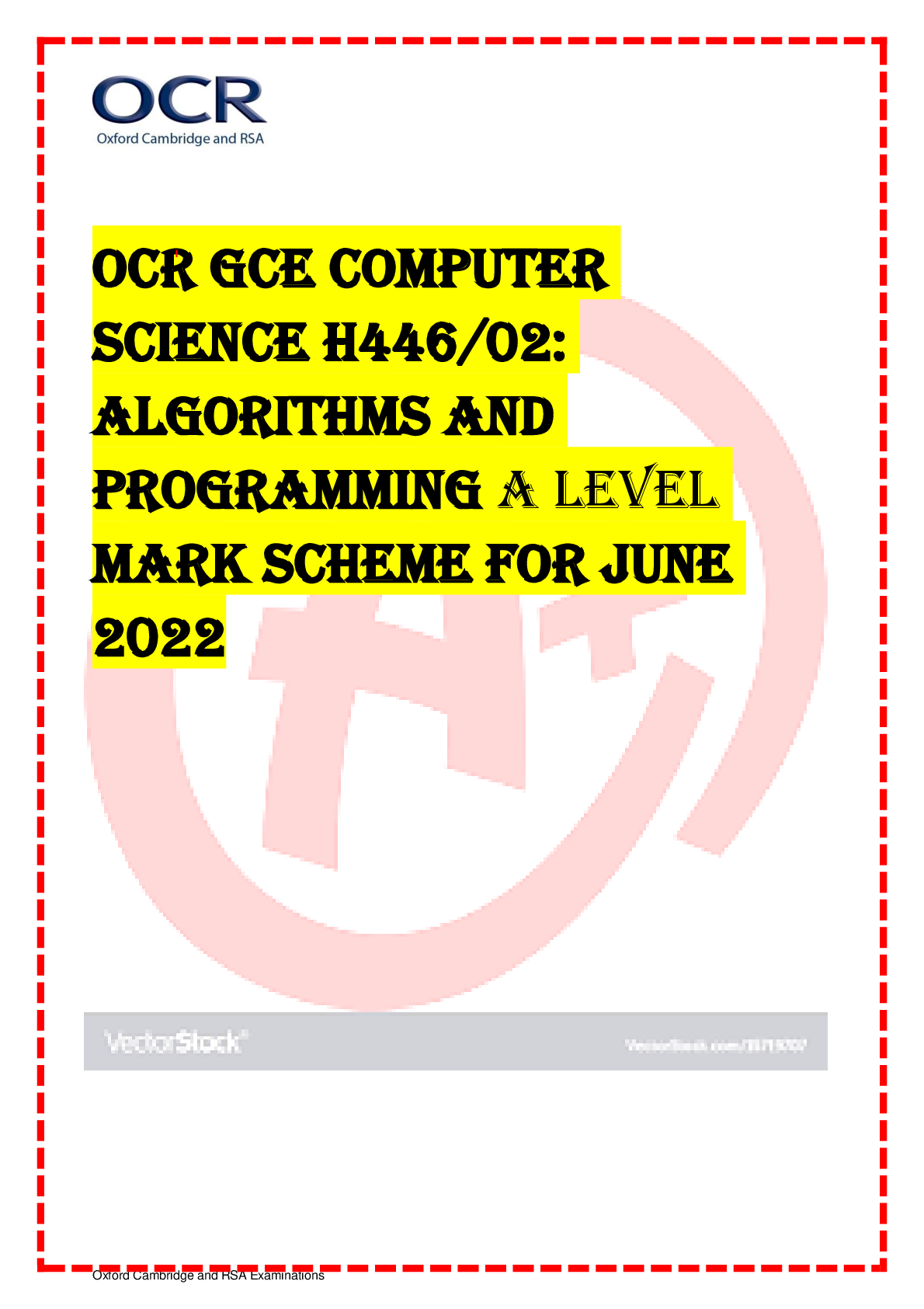Economics > AS Mark Scheme > GCE Economics H460/03: Themes in economics Advanced GCE Mark Scheme for November 2020 (All)
GCE Economics H460/03: Themes in economics Advanced GCE Mark Scheme for November 2020
Document Content and Description Below
Oxford Cambridge and RSA Examinations GCE Economics H460/03: Themes in economics Advanced GCE Mark Scheme for November 2020Oxford Cambridge and RSA Examinations OCR (Oxford Cambridge and RSA) is... a leading UK awarding body, providing a wide range of qualifications to meet the needs of candidates of all ages and abilities. OCR qualifications include AS/A Levels, Diplomas, GCSEs, Cambridge Nationals, Cambridge Technicals, Functional Skills, Key Skills, Entry Level qualifications, NVQs and vocational qualifications in areas such as IT, business, languages, teaching/training, administration and secretarial skills. It is also responsible for developing new specifications to meet national requirements and the needs of students and teachers. OCR is a not-for-profit organisation; any surplus made is invested back into the establishment to help towards the development of qualifications and support, which keep pace with the changing needs of today’s society. This mark scheme is published as an aid to teachers and students, to indicate the requirements of the examination. It shows the basis on which marks were awarded by examiners. It does not indicate the details of the discussions which took place at an examiners’ meeting before marking commenced. All examiners are instructed that alternative correct answers and unexpected approaches in candidates’ scripts must be given marks that fairly reflect the relevant knowledge and skills demonstrated. Mark schemes should be read in conjunction with the published question papers and the report on the examination. © OCR 2020H460/03 Mark Scheme November 2020 9 Annotations Annotation Meaning Blank Page – this annotation must be used on all blank pages within an answer booklet (structured or unstructured) and on each page of an additional object where there is no candidate response. Tick Cross Confused Benefit of doubt AO1 – Knowledge and understanding AO2 – Apply knowledge and understanding AO3 - Analyse AO4 - Evaluation Omission Not answered question Noted but no credit given Too vague Own figure ruleH460/03 Mark Scheme November 2020 9 Subject–specific Marking Instructions INTRODUCTION Your first task as an Examiner is to become thoroughly familiar with the material on which the examination depends. This material includes: • the specification, especially the assessment objectives • the question paper and its rubrics • the mark scheme. You should ensure that you have copies of these materials. You should ensure also that you are familiar with the administrative procedures related to the marking process. These are set out in the OCR booklet Instructions for Examiners. If you are examining for the first time, please read carefully Appendix 5 Introduction to Script Marking: Notes for New Examiners. Please ask for help or guidance whenever you need it. Your first point of contact is your Team Leader. USING THE MARK SCHEME Please study this Mark Scheme carefully. The Mark Scheme is an integral part of the process that begins with the setting of the question paper and ends with the awarding of grades. Question papers and Mark Schemes are developed in association with each other so that issues of differentiation and positive achievement can be addressed from the very start. This Mark Scheme is a working document; it is not exhaustive; it does not provide ‘correct’ answers. The Mark Scheme can only provide ‘best guesses’ about how the question will work out, and it is subject to revision after we have looked at a wide range of scripts. The Examiners’ Standardisation Meeting will ensure that the Mark Scheme covers the range of candidates’ responses to the questions, and that all Examiners understand and apply the Mark Scheme in the same way. The Mark Scheme will be discussed and amended at the meeting, and administrative procedures will be confirmed. Co–ordination scripts will be issued at the meeting to exemplify aspects of candidates’ responses and achievements; the co–ordination scripts then become part of this Mark Scheme. Before the Standardisation Meeting, you should read and mark in pencil a number of scripts, in order to gain an impression of the range of responses and achievement that may be expected.H460/03 Mark Scheme November 2020 9 In your marking, you will encounter valid responses which are not covered by the Mark Scheme: these responses must be credited. You will encounter answers which fall outside the ‘target range’ of Bands for the paper which you are marking. Please mark these answers according to the marking criteria. Please read carefully all the scripts in your allocation and make every effort to look positively for achievement throughout the ability range. Always be prepared to use the full range of marks. Levels of response / Level descriptors Knowledge and understanding/ Application Analysis Evaluation Strong Precision in the use of the terms in the question and applied in a focused way to the context of the question. An explanation of causes and consequences, fully developing the links in the chain of argument. A conclusion is drawn weighing up both sides, and reaches a supported judgement. Good An explanation of causes and consequences, developing most of the links in the chain of argument. A conclusion is drawn weighing up both sides, but without reaching a supported judgement. Reasonable Awareness of the meaning of the terms in the question and applied to the context of the question. An explanation of causes and consequences, which omit some key links in the chain of argument. Some attempt to come to a conclusion, which shows some recognition of the influencing factors. Limited Awareness of the meaning of the terms in the question. Simple statement(s) of cause and consequence. An unsupported assertion. INSTRUCTIONS TO EXAMINERS: The indicative content indicates the expected parameters for candidates’ answers, but be prepared to recognise and credit unexpected approaches where they show relevance. Using ‘best-fit’, decide first which set of BAND DESCRIPTORS best describes the overall quality of the answer. Once the band is located, adjust the mark concentrating on features of the answer which make it stronger or weaker following the guidelines for refinement.H460/03 Mark Scheme November 2020 9 • Highest mark: If clear evidence of all the qualities in the band descriptors is shown, the HIGHEST Mark should be awarded. • Lowest mark: If the answer shows the candidate to be borderline (i.e. they have achieved all the qualities of the bands below and show limited evidence of meeting the criteria of the band in question) the LOWEST mark should be awarded. • Middle mark: This mark should be used for candidates who are secure in the band. They are not ‘borderline’ but they have only achieved some of the qualities in the band descriptors. Be prepared to use the full range of marks. Do not reserve (e.g.) high marks ‘in case’ something turns up of a quality you have not yet seen. If an answer gives clear evidence of the qualities described in the band descriptors, reward appropriately.H460/03 Mark Scheme November 2020 9 Multiple Choice Questions Answer 1 C 2 D 3 B 4 A 5 B 6 D 7 C 8 D 9 B 10 D 11 C 12 D 13 D 14 A 15 C Multiple Choice Questions Answer 16 A 17 D 18 C 19 A 20 B 21 C 22 C 23 A 24 C 25 C 26 D 27 B 28 B 29 D 30 CH460/03 Mark Scheme November 2020 20 Q Key Rationale AO Quantitative skills 1 C A Only one factor of production needs to be fixed to be in the short run. B This is the long run. C Correct: The short run is a period of time in which at least one of the factors of production cannot be varied. D This does not define either the short or the long run – it is possible to have a short run and long run situation in which there is at least one variable factor of production. AO1 2 D A This would cause the LRPC to shift to the left. B This would cause a shift in the SRPC. C This is likely to cause an extension along the SPRC, rather than a contraction. D Correct: In the short run workers misinterpret an increase in their nominal wage as an increase in their real wage, meaning they supply more labour – they have not yet realised that inflation has increased. AO3 3 B A Incorrect formula: XED = % change in price of good X / % change in quantity demanded of good y. 1.7 = % change in price of good X / 4.5%. % change in price of good X = 1.7 x 4.5 = 7.65%. P1 = £2.50 / 1.0765 = £2.32. B Correct: 1.7 = 4.5 / % change in price of good X. % change in price = 4.5/1.7 = 2.647%. P1 x 1.02647 = £2.50. P1 = £2.50 / 1.02647 = £2.44. C Incorrectly calculates % change in price of good X to be 1.7/4.5 = 0.378%. P1 = £2.50 / 1.00378 = £2.49. D Incorrectly specifies £2.50 as the original price so calculates the new price as £2.50 x 1.02647 = £2.57. AO2 4 A A Correct: This would increase demand for imports, increasing the supply of the currency and causing an exchange rate depreciation. B This would increase demand for exports, increasing demand for the currency and causing an exchange rate appreciation. AO1H460/03 Mark Scheme November 2020 20 Q Key Rationale AO Quantitative skills C This would increase demand for exports, increasing demand for the currency and causing an exchange rate appreciation. D This would increase demand for exports, increasing demand for the currency and causing an exchange rate appreciation. 5 B A The price will increase as a result of the quota being imposed as US consumers no longer have access to plentiful supply of cheap imports. B Correct: The new supply curve is STotal, giving a market equilibrium price of P2. Consumption will therefore be at Q5, with Q2 being domestic production as this is the amount domestic producers are willing to supply at a price of P2. C This incorrectly assumes that there will be no imports – a quota still allows for some imports. D This would be the market price if there was an embargo on imports. AO3 6 D A Interest is the return paid to capital. B Profit is the return to enterprise. C Rent is the return to land. D Correct: Wages is the return to labour. AO1 7 C A This is where an individual cannot be stopped from consuming a good, even if they haven’t paid for it. B This is where an individual cannot opt out of consuming a good. C Correct: The individual in London is not competing for the use of the good with an individual in Sunderland – consumption is non-rivalrous. D This is not a feature of a public good. AO1 8 D A This is likely to cause a shift in long run aggregate supply or a shift in aggregate demand, not a movement along the aggregate demand curve. B This would cause a shift of the AD curve rather than a movement along it. AO3 H460/03 Mark Scheme November 2020 20 Q Key Rationale AO Quantitative skills C This would cause a shift of the AD curve rather than a movement along it. D Correct: As the price level decreases the real value of households’ wealth increases, which increases consumption. 9 B A This would increase the wealth of asset holders, increasing wealth inequality. B Correct: A decrease in income inequality will mean those at the bottom of the distribution can afford to save more to acquire wealth, whilst the ability of those at the top of the income distribution to build their wealth will be reduced. C This increases wealth inequality as home owners become wealthier whilst those without a home find it harder to get on the property ladder. D This would increase wealth inequality as more wealth will be passed between generations, benefitting wealthier individuals whose wealth previously exceeded the tax-free threshold but now falls below it. AO3 10 D A This is most likely to occur in an oligopoly market and will cause allocative inefficiency. B This is unlikely to achieve allocative efficiency because in a natural monopoly it is more efficient to have just one firm in the market to avoid the wasteful duplication of resources. C This could lead to allocative efficiency when there is market failure caused by information failure. D Correct: If the government allows one firm to operate in the market but regulates it by, for example, setting pricing rules, the benefits of economies of scale can be enjoyed without firms using their monopoly power to exploit consumers. AO3 11 C A This is a protectionist policy. B This is monetary policy. C Correct: This will create a profit incentive, which is likely to improve productivity and increase the productive capacity of the economy. D This is monetary policy. AO1H460/03 Mark Scheme November 2020 20 Q Key Rationale AO Quantitative skills 12 D A If the Marshall-Lerner condition holds an exchange rate appreciation would increase a current account deficit. B If the Marshall-Lerner condition holds an exchange rate appreciation would increase a current account deficit. C This is confusing the J-curve with the Marshall-Lerner condition. J-curve theory suggests the Marshall-Lerner condition will only hold in the long run, which explains the statement, but the question only states that the Marshall-Lerner condition holds without reference to a time period – this means the current account deficit will reduce as a result of an exchange rate depreciation. D Correct: An exchange rate depreciation will reduce the price of exports, increasing export demand, and increase the price of imports, reducing import demand. When the sum of the price elasticities of demand for imports and exports exceeds 1, this will result in a reduction in the current account deficit. AO1 13 D A This is an external diseconomy of scale B This is X-inefficiency C This is an external economy of scale D Correct: This is an internal diseconomy of scale, as the growth in the size of the firm harms worker morale and leads to productivity falling, increasing long run average cost. AO3 14 A A Correct: Foreign investors will get a relatively greater return from investing in the economy because the interest rate has fallen by less than in other economies, which will cause hot money to flow into the economy. This increases the demand for the currency, causing the value of it to appreciate. B The exchange rate will appreciate as a result of hot money flowing in. C Although the interest rate has fallen, it has fallen by less than in other countries, meaning hot money will flow in. D Although the interest rate has fallen, it has fallen by less than in other countries, meaning hot money will flow in. AO1H460/03 Mark Scheme November 2020 20 Q Key Rationale AO Quantitative skills 15 C A X-efficiency will also occur as firms would be driven out of the market if they were not operating on their lowest attainable average cost curve. Firms will not be dynamically efficient as they will not have the supernormal profit to invest in research & development. B Firms will not be dynamically efficient as they will not have the supernormal profit to invest in research & development. C Correct: Firms will produce at the minimum efficient scale, price equal to marginal cost and be operating on their lowest attainable average cost curve. D Firms will not be dynamically efficient as they will not have the supernormal profit to invest in research & development. AO1 16 A A Correct: This is a component of narrow money, along with notes and coins. B This is part of broad money, and is more illiquid than narrow money. C This is part of broad money, and is more illiquid than narrow money. D This is part of broad money, and is more illiquid than narrow money. AO1 17 D A Corporation tax is a tax on profit so does not affect labour costs. B An increase in output would only cause a decrease in unit labour costs if caused by an increase in labour productivity – if output has simply risen because more workers have been employed then unit labour costs will be unchanged. C This would increase unit labour costs. D Correct: This would increase labour productivity, reducing unit labour costs. AO1 18 C A This is the marginal propensity to withdraw (0.11 + 0.23 + 0.17) = 0.51 B Calculates the multiplier by adding all terms in the table together = 0.71 + 0.11 + 0.23 + 0.17 + 0.42 = 1.64 C Correct: Multiplier = 1 / MPW = 1 / (0.11 + 0.23 + 0.17) = 1 / 0.51 = 1.96 D Calculates the multiplier as 1 / MPM + MPS = 1 / 0.11 + 0.23 = 2.94 AO2 H460/03 Mark Scheme November 2020 20 Q Key Rationale AO Quantitative skills 19 A A Correct: Without money to act as a medium of exchange goods and services will need to be traded directly for each other. B There would be no role for a central bank in an economy without money. C In an economy without money goods and services are traded directly for each other – there is therefore no one price of a good or service, making price controls less likely. D Protectionism places restrictions upon imports into a country – this is not related to the existence of money. AO1 20 B A Whilst being a member of a free trade area might give Germany preferential access to UK markets, this is an alternative explanation of global trading patterns. B Correct: Because Germany can produce cars at a lower opportunity cost than the UK, it is more efficient for the UK to specialise in the production of goods it has a comparative advantage in and import cars from Germany – this enables consumption to be enjoyed beyond an economy’s production possibilities. C This is an explanation of absolute rather than comparative advantage. D Whilst being located closer to a trading partner can reduce costs of transportation and increase trade, this is an alternative explanation of global trading patterns. AO1 21 C A This will reduce the effectiveness of expansionary fiscal policy. B This will reduce the effectiveness of expansionary monetary policy. C Correct: In this circumstance there is significant spare capacity, rendering supply side policy ineffective as it would simply create more spare capacity. Demand side policy would be more effective. D This suggests supply side policy would be very effective because the economy is likely to be operating close to full capacity. AO1 22 C A Incorrectly includes ‘Others’ as one of the 3 firms: 33.2 + 37.6 + 18.8 – 24.8 – 32.9 – 31.3 = decreased by 0.6%. AO2 H460/03 Mark Scheme November 2020 20 Q Key Rationale AO Quantitative skills B This explains what has happened to the 4 firm concentration ratio: 33.2 + 37.6 + 2.4 – 24.8 – 10.6 – 0.4 – 31.3 = decreased by 6.1%. C Correct: 3 firm concentration ratio in 2010 = 37.6 + 33.2 + 2.4 = 73.2%. 3 firm concentration ratio in 2019 =31.3 + 24.8 + 10.6 = 66.7%. 3 firm concentration ratio has decreased by 73.2 – 66.7 = 6.5%. D Uses the same 3 firms in 2019 as in 2010: 33.2 + 37.6 + 2.4 – 24.8 – 0.4 – 31.3 = decreased by 16.7%. 23 A A Correct: There is allocative inefficiency arising from underproduction because MSB>MSC, meaning the benefit gained by society from an extra unit of production is greater than the cost to society of producing an extra unit. B This is a long run concept that takes into account the extent to which product development is taking place in the long run – it cannot be shown on this diagram. C It is not possible to tell from this diagram whether firms are operating at their lowest long run average cost because there is no average cost curve. D It is not possible to tell from this diagram whether firms are operating with organisational slack because there is no average cost curve. AO3 24 C A There is no environmental component in the HDI. B The output component in the HDI is GNI per capita at PPP, not GDP per capita. C Correct: This acts as a proxy for the quality of healthcare in the country. D The education component of the HDI is mean years of schooling and expected years of schooling. AO1 25 C A This would make labour supply inelastic which is likely to lead to higher wages. B This is likely to lead to higher wages as workers enjoy a union ‘mark-up’. C Correct: This would make labour demand more wage elastic, which reduces the bargaining power of workers and leads to lower wages. AO1H460/03 Mark Scheme November 2020 20 Q Key Rationale AO Quantitative skills D This would lead to higher wages as there would be a high demand for labour. 26 D A This is where individuals consume too much of a good because they overestimate the benefits of consuming the good – in this scenario, there is underconsumption because women are not fully aware of the benefits. B This is where there are third party harms associated with the consumption of the good – there is no evidence of that here. C This is where individuals do not consume the good because they do not care about third party benefits – the scenario set up here clearly implies women do not consume folic acid because they are unaware of the beneficial impacts to their baby of doing so. D Correct: There is information failure meaning women are not fully aware of the benefits of consuming folic acid, leading to underconsumption. The information provision is designed to increase awareness and in doing so increase consumption. AO2 27 B A Calculates the inflation rate as 101.9 – 103.4 = -1.50% B Correct: Inflation rate = (101.9 – 103.4) / 103.4 x 100 = -1.45% C Calculates the inflation rate as (103.4 – 101.9) / 101.9 x 100 = 1.47% D Calculates the inflation rate as 101.9 – 100 = 1.90% AO2 28 B A This describes substitutes – where two goods are in competition with each other. B Correct: Composite demand is where one good is demanded for multiple uses. This is the case with wood. C This describes complements – where two goods are demanded together. D This is the aggregation of individual demand. AO2H460/03 Mark Scheme November 2020 20 Q Key Rationale AO Quantitative skills 29 D A An outward shift in the production possibility curve enables more production to take place. B The production of hair straighteners can increase because the shift will have been caused by an increase in the efficiency in the production of hair straighteners – a technology biased shift. C This would only be true if the economy was exclusively producing apples. At point X an increase in the efficiency of the production of hair straighteners will enable more apples to be produced because resources can be reallocated from the production of hair straighteners. D Correct: Hair straighteners can be produced using less resources, meaning the production of hair straighteners can be increased whilst resources can be reallocated to the production of apples to enable the production of apples to also increase. AO3 30 C A This would be used to prevent firms from exploiting their market power – it would not help prevent a run on a bank. B This is a form of monetary policy, not financial regulation. C Correct: Forcing a bank to keep a higher liquidity ratio will decrease the risk of a run on a bank, because banks will have more money readily available to pay depositors who are requesting their funds. This will increase confidence amongst depositors. D This is a form of monetary policy, not financial regulation. AO1H460/03 Mark Scheme November 2020 20 Question Answer Marks Guidance 31 Using Fig 1.1, explain the relationship between the budget deficit and national debt between 2010 and 2019. • The budget deficit was falling whilst national debt was rising (1) • Budget deficit has decreased by £115bn and national debt has increased by £600bn. (1) • This is because government debt is an accumulation of previous deficits, each year there is a budget deficit national debt increases / A budget deficit increases national debt because the government has to borrow to finance a deficit, which increases debt (1) • As the budget deficit decreased the national debt increased at a slower rate (1) 2 AO2 x 2 A simple statement that there is an inverse relationship should not be credited. Use of the data requires calculations – simply stating the size of the budget deficit and national debt at the start and end of the period is not enough. For the mark to be awarded the change in the budget deficit and national debt must both be calculated. Accept budget deficit decreases in the range of £110bn – £120bn and national debt increases in the range of £550bn - £725bn. 32 Explain, using an example from Extract 1, what is meant by capital expenditure. Award 1 mark for an explanation of capital expenditure: • Investment • Spending that has a long-term benefit • Spending that increases productive capacity Award 1 mark for an example of capital expenditure from Extract 1: • Green transformation fund • Insulating 27 million homes • Building of social housing • Building new hospitals/schools/police stations 2 AO1 x 1 AO2 x 1 Spending on NHS/schools/police must be explicitly linked to capital rather than current expenditure to be credited.H460/03 Mark Scheme November 2020 20 Question Answer Marks Guidance 33 Evaluate, with the use of an appropriate diagram(s), whether ending austerity is likely to result in the government achieving higher levels of economic growth. Level 3 (11–15 marks) Good knowledge and understanding of expansionary fiscal policy and economic growth. Good – strong analysis of the impact of ending austerity on economic growth. Good analysis will be in the form of developed links. These links are developed through a chain of reasoning which addresses the question. Any relevant diagram(s) are predominantly correct and linked to the analysis. Strong analysis will have consistently well-developed links through a coherent chain of reasoning which addresses the question. Any relevant diagram(s) are predominantly correct with no significant errors that affect the validity of the analysis. Any diagrams must be integral to the analysis. Good - strong evaluation of the impact of austerity on economic growth, weighing up both sides/comparing alternatives. Strong evaluation should include a supported judgment. There is a well-developed line of reasoning which is clear and logically structured. The information presented is relevant and substantiated. Level 2 (6–10 marks) Good knowledge and understanding of expansionary fiscal policy and economic growth. Reasonable analysis of the impact of ending austerity on economic growth. There is correct analysis largely in the 15 (AO1 x 2 AO2 x 3 AO3 x 4 AO4 x 6) Guidance: • A number of limited analytical/evaluative points can be awarded up to Reasonable, but to be awarded Good or Strong there needs to be greater depth of explanation. • A relevant and explained diagram is required for the Analysis or Evaluation to be awarded above Reasonable. • Strong evaluation requires an explained judgement. An explained judgement without Good evaluation can be credited as evaluation. • The side of the argument presented first should be credited as Analysis, with the other side credited as Evaluation. Knowledge & Understanding: Knowledge & Understanding marks should be awarded for impacts of ending austerity that are mentioned in the case study: o Greek economy collapsed because of high debt/GDP ratio. o UK debt/GDP ratio was 69% in 2010 and forecast to increase to more than 100%. o Austerity is crucial in promoting future economic growth and stability. o Conservatives committed to increase public expenditure and cut taxes. o Labour committed to public sector pay rises, green transformation fund, compensating WASPI women and building social housing. o Low cost of borrowing. o UK has a relatively low debt/GDP ratio. o Destroys reputation of fiscal responsibility.H460/03 Mark Scheme November 2020 20 Question Answer Marks Guidance form of single links. These address the question but are not developed into a clear chain of reasoning. Any relevant diagram(s) may be imperfectly labelled or not linked to the analysis. Reasonable evaluation of the impact of austerity on economic growth. There is a line of reasoning presented with some structure. The information presented is in the most-part relevant and supported by some evidence. Level 1 (1–5 marks) Limited – reasonable knowledge and understanding of expansionary fiscal policy and/or economic growth. Limited analysis of the impact of ending austerity on economic growth. There is little evidence of reasoning that addresses the question asked. There is a lack of a clear structure. Limited evaluation of the impact of ending austerity on economic growth or no evaluation. The information is basic and communicated in an unstructured way. The information is supported by limited evidence and the relationship to the evidence may not be clear. 0 marks no response or no response worthy of credit. Analysis and Evaluation requires candidates to go beyond what is given in the case study. Analysis may include: • Increasing public expenditure will result in AD increasing (G is a component of AD). • Tax cuts will increase consumption, increasing AD. • Increases in AD will generate economic growth. • Multiplier effect will result in further increases in consumption and investment, triggering further economic growth. • Accelerator effect may result in economic growth increasing still further. • Capital expenditure will result in productive capacity of the economy increasing – outward shift in LRAS will result in non-inflationary sustainable economic growth. Evaluation may include: • Public expenditure may crowd out private sector investment, meaning AD may not increase. • Multiplier may not be significant if leakages are large. • Depends on state of the global economy – interdependence means expansionary fiscal policy in UK may be ineffective if export markets are in recession. • Consumer and business confidence may fall if fiscal policy is not seen as credible, which could result in rising saving and falling consumption and investment. • Growth may fall in the future if future governments have to increase taxes/cut spending to pay back the debt it built up when increasing spending. • Depends on whether the capital expenditure results in economy growing enough to mean debt/GDP ratio falls despite higher levels of borrowing.H460/03 Mark Scheme November 2020 20 Question Answer Marks Guidance 34 Using Fig. 2.1, compare what happened to the price of water and electricity between 1990 and 2018. Award up to 2 marks for a comparison of changes in the nominal price of water and electricity: • The price of water and electricity both increased. (1) • Water prices rose by more than electricity prices (1), with water prices rising by 260% and electricity prices rising by 205% (1) Award up to 2 marks for a comparison of changes in the real price of water and electricity: • The real price of water and electricity both increased (1) • The real price of electricity only started rising significantly after 2006, whereas the real price of water was increasing throughout the period (1) 3 AO2 x 3 Award 2 marks for a statement that water prices increased by approximately 55% more than electricity prices. For candidates to secure full marks on this question a consideration of both real and nominal prices is required.H460/03 Mark Scheme November 2020 20 Question Answer Marks Guidance 35 Explain the likely objective of a water or electricity firm if it operated in the public sector. • A public sector firm will seek to maximise social welfare/utility/achieve allocative efficiency (1) • Government funds public services to deliver high levels of consumer satisfaction to the population (1) • This means they will consider private and external costs and benefits (1), unlike a private sector firm which will only care about profit (1). • Public sector firms aim to keep prices as low/quality as high as possible for consumers (1) 3 AO1 x 2 AO3 x 1 Candidates must recognise that the public sector is government funded to get the second mark exemplified here. A simple statement that private sector firms seek to maximise profit should not be credited unless compared to a public sector firm. 36 Evaluate, using the information in Extract 2, whether the likely objective of a private sector water or electricity firm justifies taking them into public ownership. Level 2 (5–8 marks) Good knowledge and understanding of objectives of firms. Good – strong analysis of whether the likely objective of a private sector water or electricity firm justifies taking them into public ownership. Good analysis will be in the form of developed links. These links are developed through a chain of reasoning which addresses the question. Any relevant diagram(s) are predominantly correct and linked to the analysis. Strong analysis will have consistently well-developed links through a coherent chain of reasoning which addresses the 8 AO1 x 1 AO2 x 1 AO3 x 2 AO4 x 4 Guidance: • Whilst most candidates will start their answer explaining why the profit maximising nature of private sector firms justifies nationalisation, the reverse approach is equally valid. • The side of the argument presented first should be credited as Analysis, with the other side credited as Evaluation. • Strong evaluation requires an explained judgement. An explained judgement without Good evaluation can be credited as evaluation.H460/03 Mark Scheme November 2020 20 Question Answer Marks Guidance question. Any relevant diagram(s) are predominantly correct with no significant errors that affect the validity of the analysis. Any diagrams must be integral to the analysis. Reasonable – strong evaluation of whether the likely objective of a private sector water or electricity firm justifies taking them into public ownership. Good evaluation will weigh up both sides/comparing alternatives but without reaching a supported judgment. Strong evaluation should include a supported judgment. Level 1 (1–4 marks) Limited – reasonable knowledge and understanding of of objectives of firms. Limited – reasonable analysis of whether the likely objective of a private sector water or electricity firm justifies taking them into public ownership. Limited analysis will have little evidence of reasoning that addresses the question asked. There is a lack of a clear structure. Reasonable analysis will have correct analysis largely in the form of single links. These address the question but are not developed into a clear chain of reasoning. Any relevant diagram(s) may be imperfectly labelled or not linked to the analysis. Limited evaluation of whether the likely objective of a private sector water or electricity firm justifies taking them into public ownership or no evaluation. Knowledge & Understanding: Knowledge & Understanding marks should be awarded for material that is given in the case study: o Discipline of the marketplace creates competition that drives efficiency, raises revenue for the government and lowers prices. o Private firms failed to invest in London’s water mains and high-speed broadband. o Nationalisation would increase investment. o £170bn bill incurred from nationalisation. o Efficiency would be better served from tight regulation such as energy price caps of 2019. Analysis and Evaluation requires candidates to go beyond what is given in the case study. Analysis may include: • A natural monopoly that profit maximises will charge high prices because there are no substitutes. • Public utilities are likely to be natural monopolies because the high barriers to entry prevents competition. • This is particularly problematic in the case of public utilities because they are necessity goods. • Firms will enjoy significant supernormal profits that will benefit shareholders but not service users, who experience little consumer surplus as prices are high. • Firms have no incentive to undertake investment because they do not face competition. • Nationalising these firms would mean supernormal profits are redistributed to service users in the form of lower prices and/or greater investment in the quality of the service.H460/03 Mark Scheme November 2020 20 Question Answer Marks Guidance 0 marks no response or no response worthy of credit. Evaluation may include: • The cost of nationalising these firms will incur an opportunity cost and reduce the ability of the government to spend elsewhere. • The government may not have the funds to invest sufficiently, meaning the quality of the service may not improve. • X-inefficiency may result because there is no profit incentive in the public sector – this could lead to worsening productivity and rising prices and/or a worse quality of service. • Regulation of private sector firms such as setting pricing rules may be more effective – this would enable the benefits of a profit incentive to be enjoyed without consumers being exploited, providing the regulator sets the pricing cap at the right level. 37 Using Fig 3.2, explain the relationship between air travel and carbon dioxide emissions. • An increased number of air passenger journeys have contributed to rising carbon emissions. (1) • Air passenger journeys have increased (65%) by more than carbon emissions (12%). (1) • In 2014-15 carbon dioxide emissions decreased despite air travel increasing, suggesting air travel may not be the main cause of carbon emissions/the 2 AO2 x 1 AO3 x 1 Do not award a mark for ‘positive relationship’ or ‘both increased’ – there has to be an understanding that the increased air travel is contributing to the increase in carbon dioxide emissions.H460/03 Mark Scheme November 2020 20 Question Answer Marks Guidance relationship between the two variables isn’t that strong. (1) 38 Evaluate, using the information in Extract 3, the economic implications of limiting individuals to one return flight a year. Level 3 (11–15 marks) Good knowledge and understanding of market failure and or/macroeconomic policy objectives. Good – strong analysis of the economic implications of limiting individuals to one return flight a year. Good analysis will be in the form of developed links. These links are developed through a chain of reasoning which addresses the question. Any relevant diagram(s) are predominantly correct and linked to the analysis. Strong analysis will have consistently well-developed links through a coherent chain of reasoning which addresses the question. Any relevant diagram(s) are predominantly correct with no significant errors that affect the validity of the analysis. Any diagrams must be integral to the analysis. Good - strong evaluation of the economic implications of limiting individuals to one return flight a year, weighing up both sides/comparing alternatives. Strong evaluation should include a supported judgment. There is a well-developed line of reasoning which is clear and logically structured. The information presented is relevant and substantiated. Level 2 (6–10 marks) 15 (AO1 x 2 AO2 x 3 AO3 x 4 AO4 x 6) Guidance: • Candidates can approach this question from a microeconomic or macroeconomic perspective or a combination of the two. • A number of limited analytical/evaluative points can be awarded up to Reasonable, but to be awarded Good or Strong there needs to be greater depth of explanation. • Strong evaluation requires an explained judgement. An explained judgement without Good evaluation can be credited as evaluation. • The side of the argument presented first should be credited as Analysis, with the other side credited as Evaluation. Knowledge & Understanding: Knowledge & Understanding marks should be awarded for the economic implications of limiting individuals to one return flight a year that are mentioned in the case study: o CO2 emissions have increased by 90%, damaging communities around the world. o UK adopting climate change target may encourage other countries to follow. o Transportation accounts for 14% of all carbon emissions. o A journey by plane is 20 x more environmentally harmful than a journey by train. o Limiting flying will reduce negative externalities. o UK’s status as a global centre of financial services would be harmed.H460/03 Mark Scheme November 2020 20 Question Answer Marks Guidance Good knowledge and understanding of market failure and or/macroeconomic policy objectives. Reasonable analysis of the economic implications of limiting individuals to one return flight a year. There is correct analysis largely in the form of single links. These address the question but are not developed into a clear chain of reasoning. Any relevant diagram(s) may be imperfectly labelled or not linked to the analysis. Reasonable evaluation of the economic implications of limiting individuals to one return flight a year. There is a line of reasoning presented with some structure. The information presented is in the most-part relevant and supported by some evidence. Level 1 (1–5 marks) Limited – reasonable knowledge and understanding of market failure and or/macroeconomic policy objectives. Limited analysis of the economic implications of limiting individuals to one return flight a year. There is little evidence of reasoning that addresses the question asked. There is a lack of a clear structure. Limited evaluation of the economic implications of limiting individuals to one return flight a year or no evaluation. The information is basic and communicated in an unstructured way. The information is supported by limited evidence and the relationship to the evidence may not be clear. 0 marks no response or no response worthy of credit. o Would limit the gains from globalisation. o Alternative policy solutions would be less damaging. Analysis and Evaluation requires candidates to go beyond what is given in the case study. Analysis may include: • There is over-production/over-consumption of air travel due to third party harms to future generations from climate change that are ignored by the market mechanism. • Limiting the number of flights will reduce market failure and allocative inefficiency, as production and consumption will fall. This will reduce harms to third parties. • May contribute to more sustainable economic growth in the future, as productive capacity of the economy is not reduced as a result of damage to the climate. • Could promote FDI from green companies that see the UK as a global leader in green strategy/technology. Evaluation may include: • Limiting all individuals to one flight is a poorly targeted solution as there are significant social benefits to some individuals flying, particularly those travelling for business. • Increasing tax on frequent flyers may be more effective as it allows the polluter pays principle to hold. • Interfering with market forces could result in inefficiency – either over or under production of air travel could result. • AD may fall, causing negative economic growth, as a result of a decrease in investment – firms may move abroad because the UK becomes a less attractive place to do business because of restrictions on travelling.H460/03 Mark Scheme November 2020 20 Question Answer Marks Guidance • This would be particularly harmful to the UK given it relies upon FDI to fund its large current account deficit. • Unilateral action may be ineffective – it might be better for solutions to be agreed on a global level. • Ultimately air travel is still not the biggest cause of pollution, so targeting other areas, such as the development of green energy, may be more effective.H460/03 Mark Scheme November 2020 20 Question AO1 AO2 AO3 AO4 TOTAL (Quantitative skills) SECTION A TOTAL 16 6 8 30 (10) 31 2 (2) 2 (2) 32 1 1 2 33 2 (2) 3 (2) 4 (2) 6 (2) 15 (8) 34 3 (3) 3 (3) 35 2 1 3 36 1 1 2 4 8 37 1 (1) 1 (1) 2 (2) 38 2 3 4 6 15 SECTION B TOTAL 8 14 12 16 50 (15) PAPER TOTAL 24 20 20 16 80 (17)OCR (Oxford Cambridge and RSA Examinations) The Triangle Building Shaftesbury Road Cambridge CB2 8EA [Show More]
Last updated: 1 year ago
Preview 1 out of 28 pages

Reviews( 0 )
Document information
Connected school, study & course
About the document
Uploaded On
Oct 10, 2022
Number of pages
28
Written in
Additional information
This document has been written for:
Uploaded
Oct 10, 2022
Downloads
0
Views
86








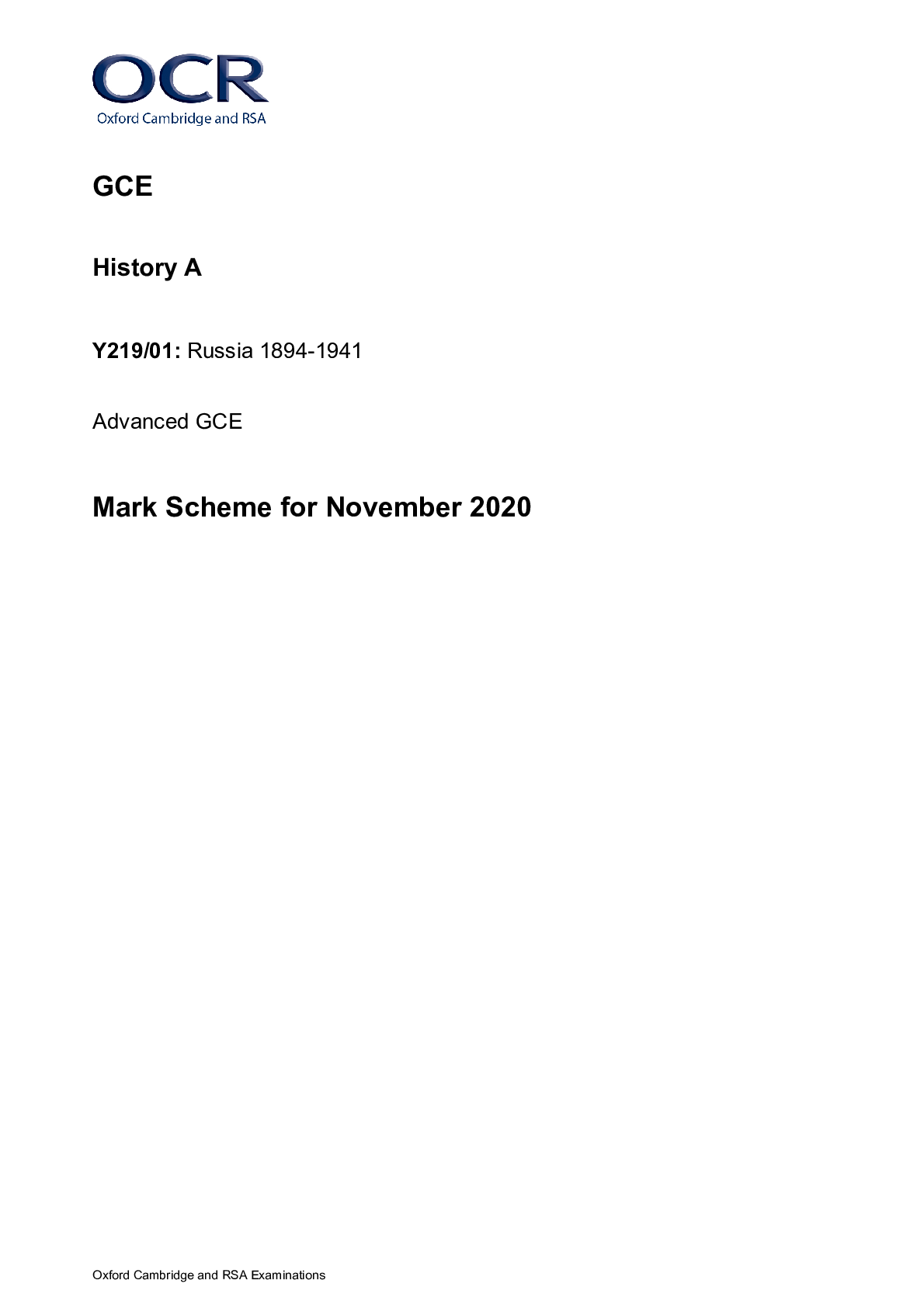
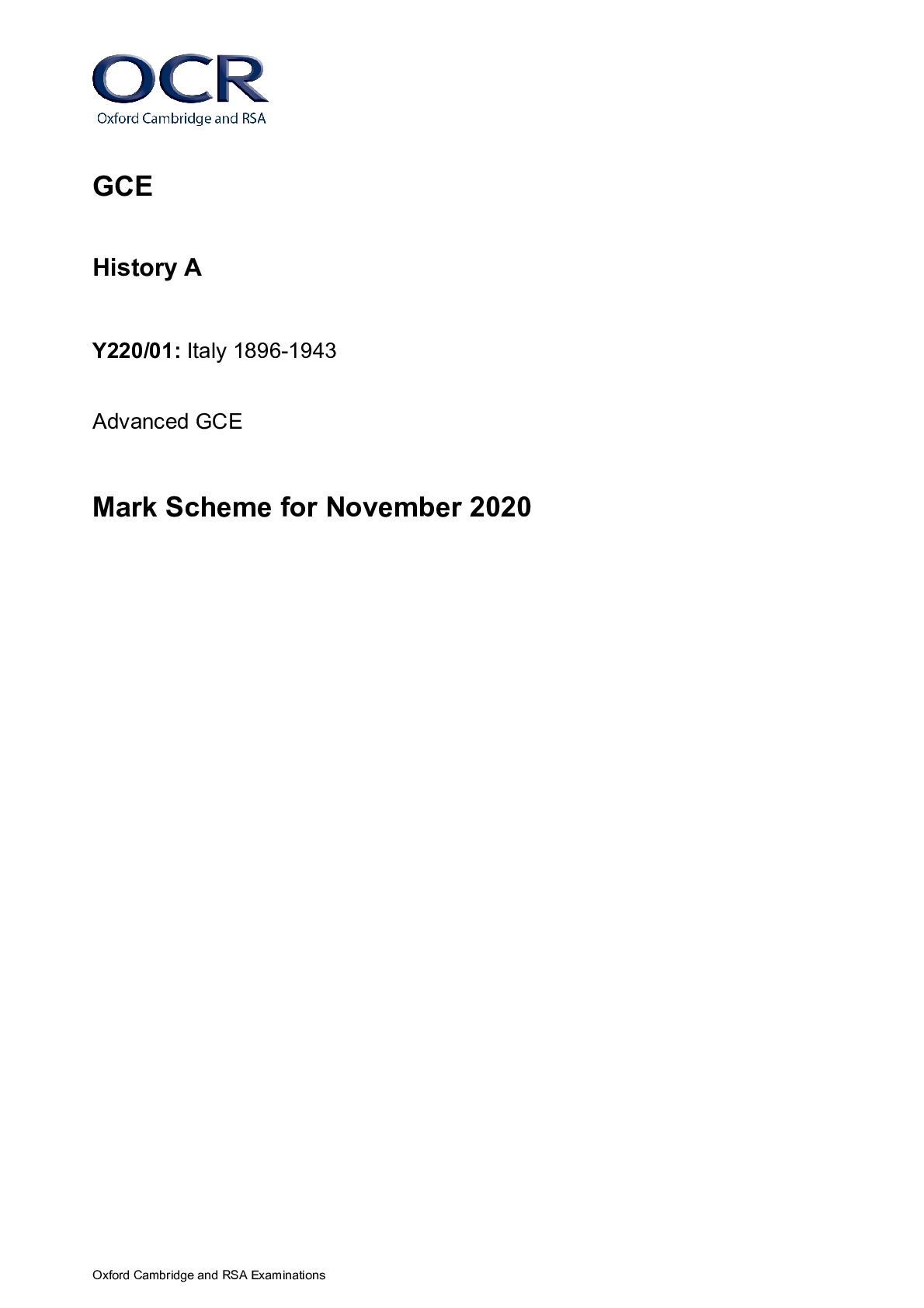

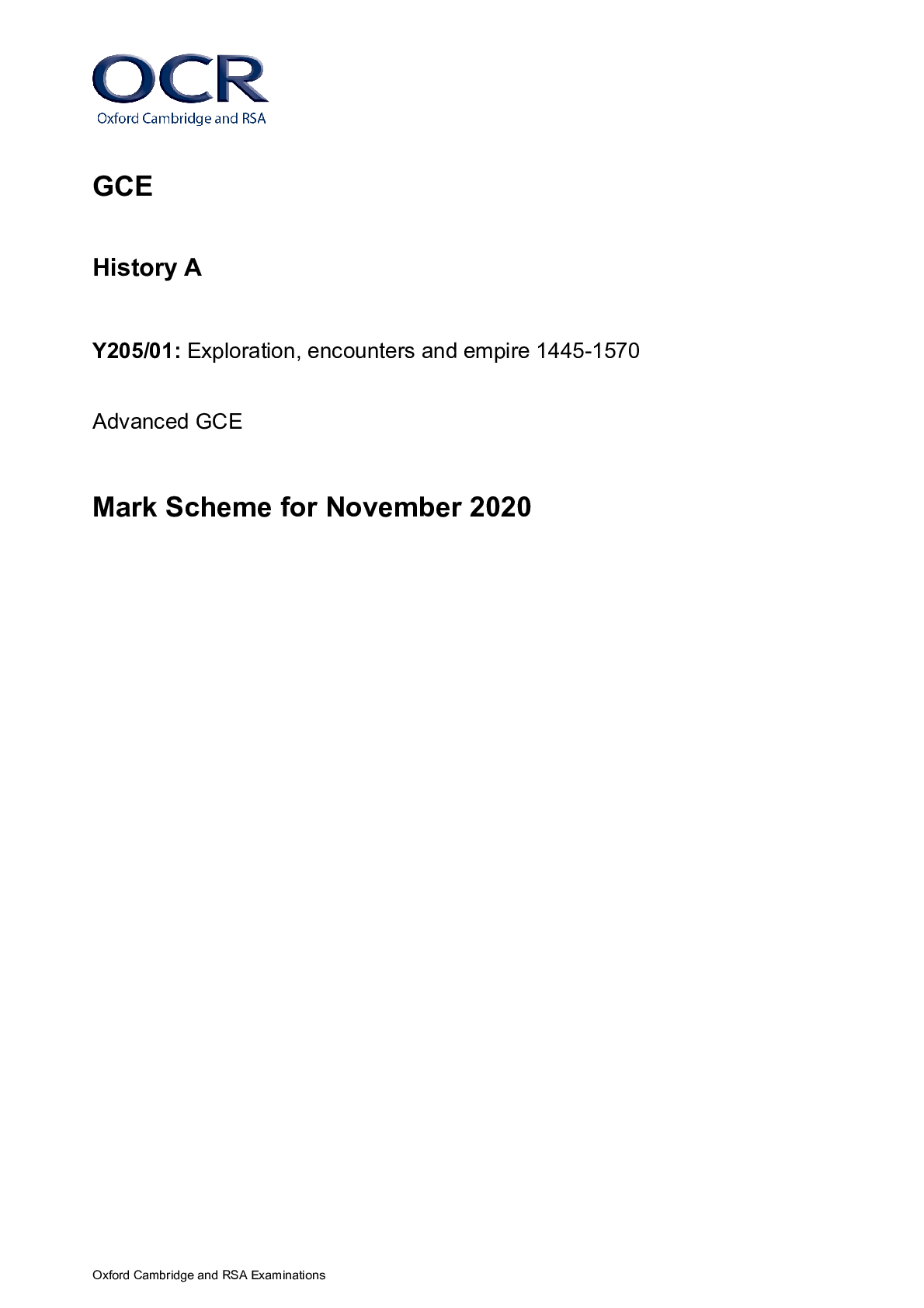
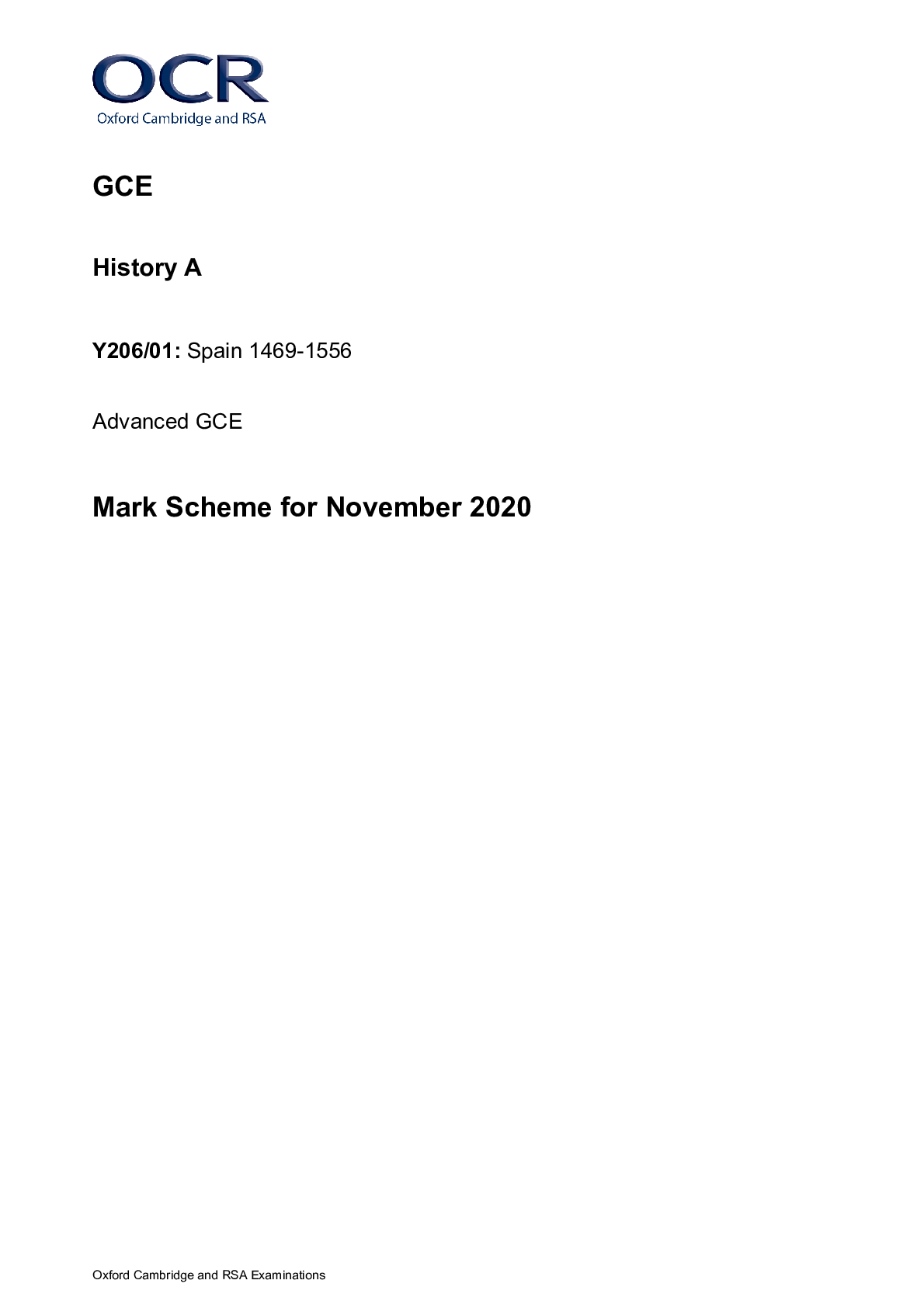
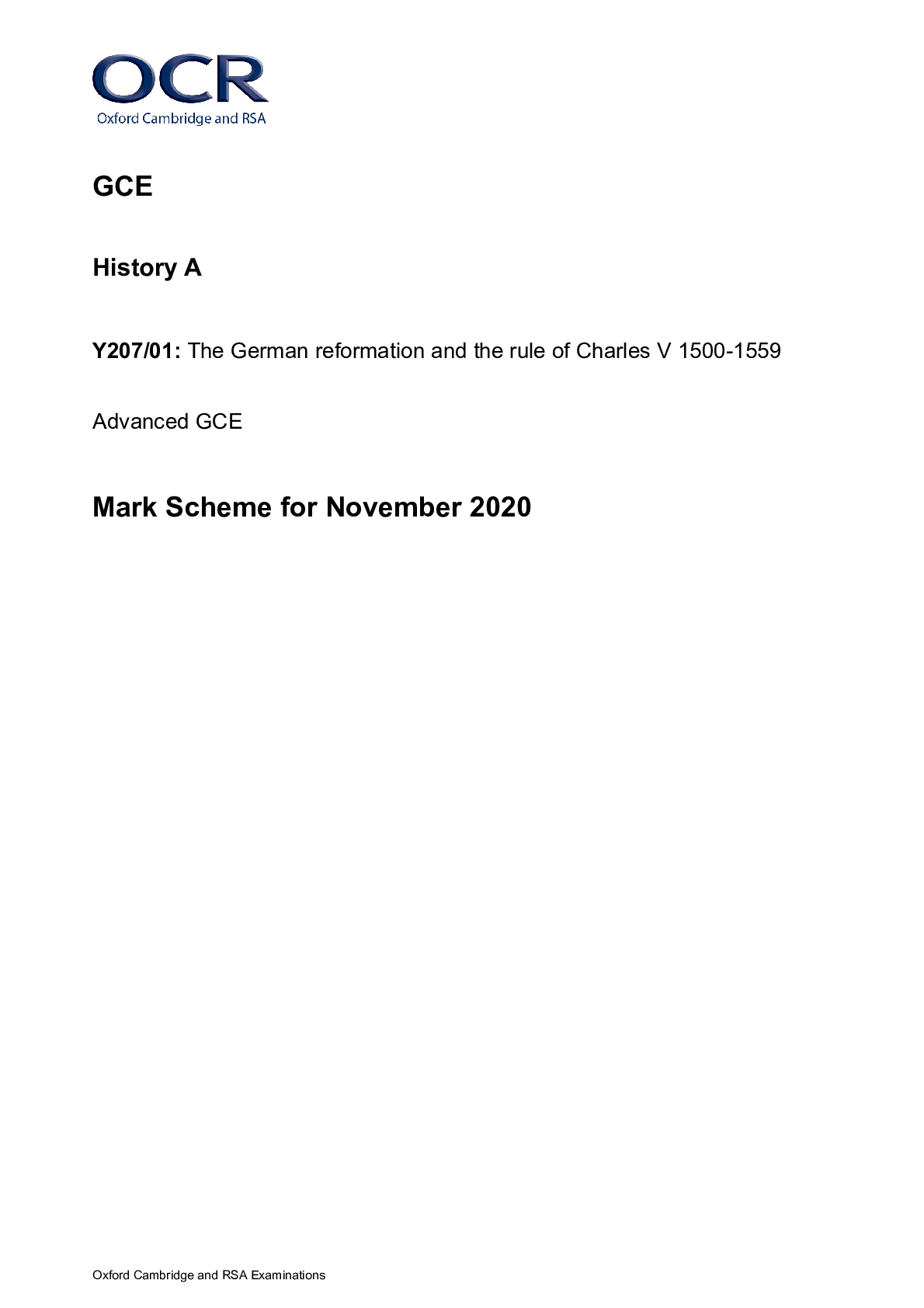
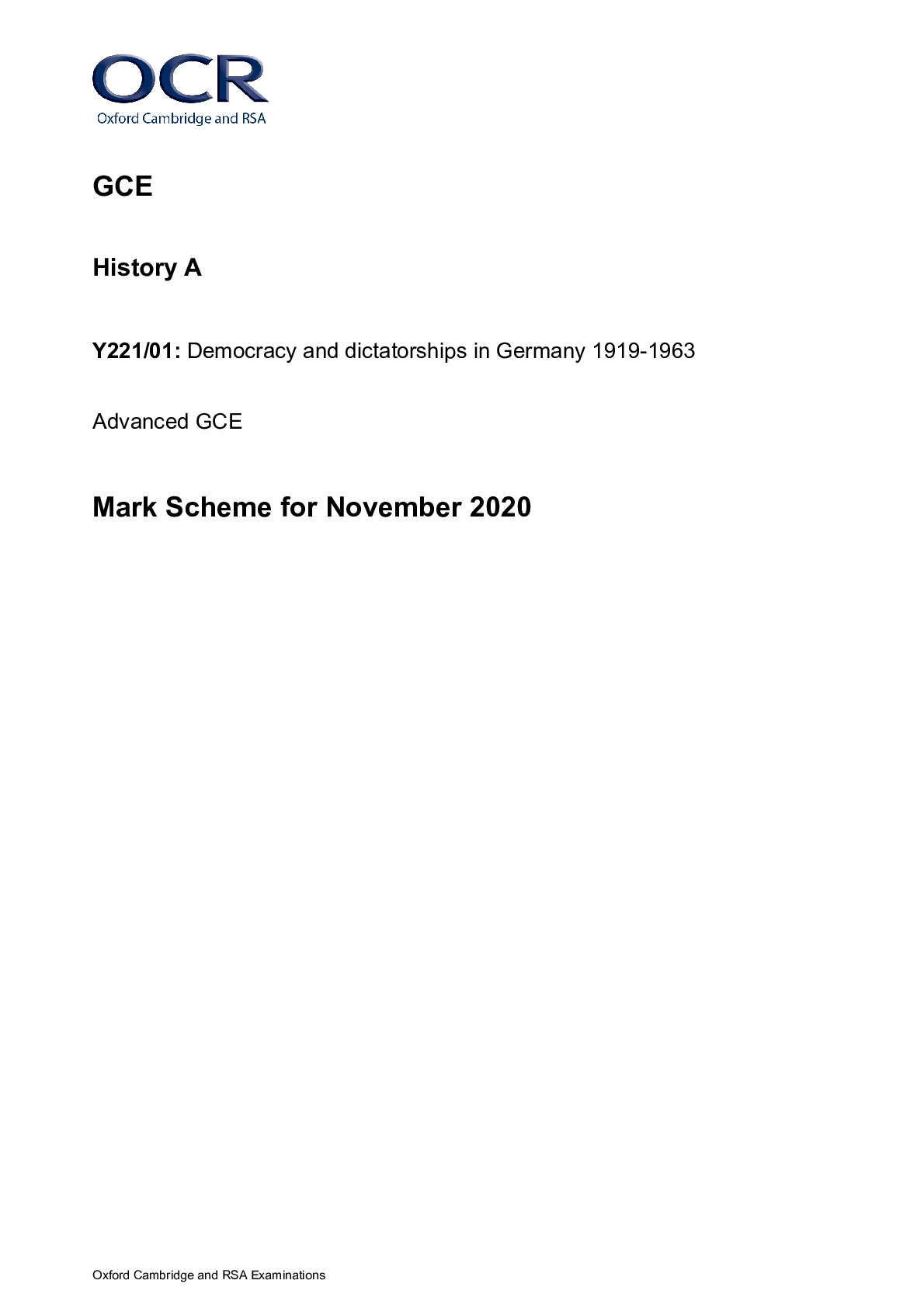

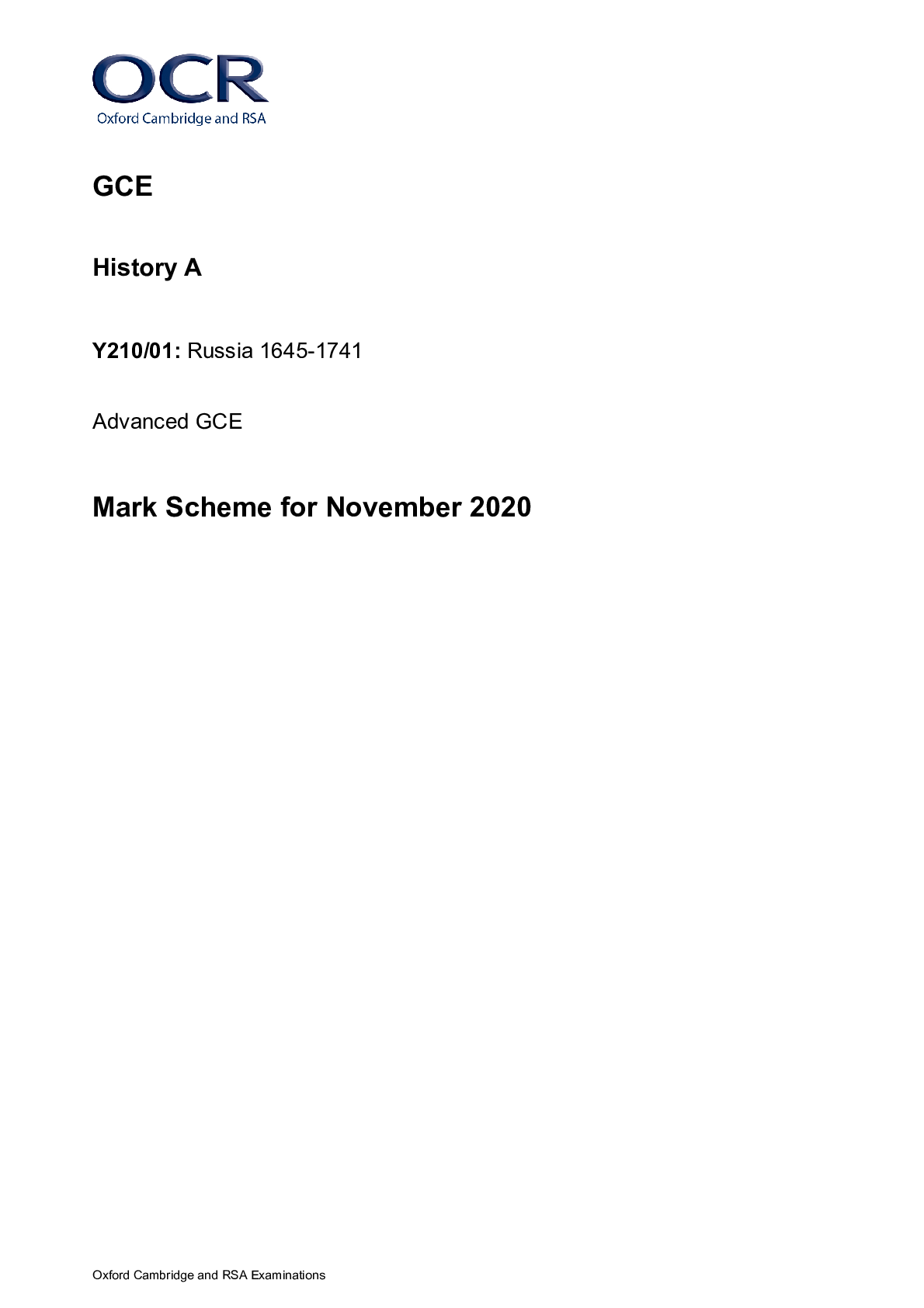


.png)



